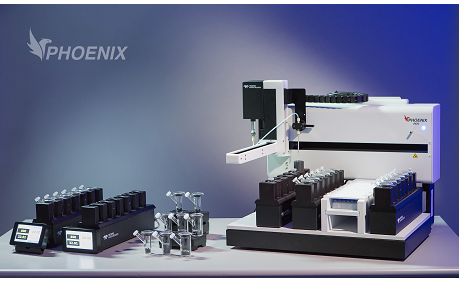

The “Microette” system of the American company Teledyne Hanson Research, based on modified Franz cells, has enjoyed great popularity among the scientists dealing with testing of transdermal formulations. The result of its fundamental redesigning by the company’s engineers is the newly released Phoenix instrument assembly, suitable for monitoring membrane diffusion processes. As with the Microette system, the most important element of the system is the cell that meets the similarity requirements of diffusion cells described in USP Chapter <1724>. Unlike the Microette water-jacketed Franz cells, these cells are so-called “dry-heat” cells, their thermostatting does not require water circulation. The cells can be placed in a modern, 6-place block thermostat, which also functions as a magnetic mixing unit. The cells with manual or automatic sampling are suitable for the development and quality control of semisolid pharmaceutical forms (creams, gels, transdermal products), eye drops, pesticides, cosmetics, or for testing diffusion processes through various membranes.
Phoenix Dry-Heat diffusion cells
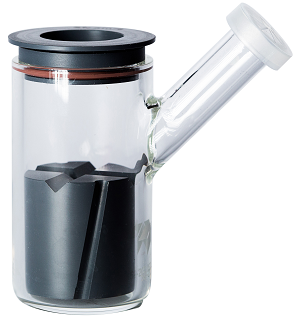 The cells for easy filling and sampling are uniformly 6 cm high, but may have different inner diameters: the smallest (S) cells have an inner diameter of 18 mm, the medium (M) is 23 mm, and the largest (L) is 28 mm. The volume of the liquid in the cell also depends significantly on the size of the PEEK or PTFE magnetic mixer, which can be 13 mm or 30 mm high. In this way, receptor liquid volumes between 10 and 30 ml can be used. The sampling port of the cells has a convenient orifice for manual and automatic pipette tips. When sampling, it is possible to take up a sample of up to 500 µl and replace the media without creating overpressure in the cell or getting air between the membrane and the receptor fluid. For testing, light sensitive formulations cells made from amber glass are recommended. Each cell has a unique serial number and a certificate.
The cells for easy filling and sampling are uniformly 6 cm high, but may have different inner diameters: the smallest (S) cells have an inner diameter of 18 mm, the medium (M) is 23 mm, and the largest (L) is 28 mm. The volume of the liquid in the cell also depends significantly on the size of the PEEK or PTFE magnetic mixer, which can be 13 mm or 30 mm high. In this way, receptor liquid volumes between 10 and 30 ml can be used. The sampling port of the cells has a convenient orifice for manual and automatic pipette tips. When sampling, it is possible to take up a sample of up to 500 µl and replace the media without creating overpressure in the cell or getting air between the membrane and the receptor fluid. For testing, light sensitive formulations cells made from amber glass are recommended. Each cell has a unique serial number and a certificate.
The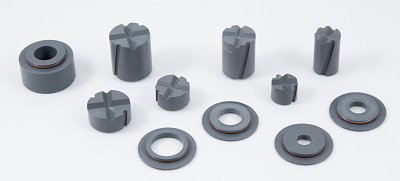 size of the diffusion surface and the amount of the formulation are determined by the formulation and membrane holder selected for the cell, which consists of three components. The inner diameter of the lower ring (9, 11.3, 15 or 20 mm) determines the surface of the membrane which will be in contact with the medium (63.6 mm2,100 mm2, 176.7 mm2, 314.2 mm2). The height (4, 7, 13 or 20 mm) and the design of the middle part affects the amount of the dosage and the usable membrane thickness. The 4 mm and 20 mm-high units are for the max. 1 mm-thick and 25 mm diameter membranes (e.g. Strat-M and other synthetic membranes). The 7 and 13 mm height units are recommended for the max. 3 mm thick membranes (e.g. natural and artificial skins). The 4 mm and 7 mm-high units are recommended for the formulations with high viscosity (creams, ointments). The 20 mm unit is recommended for the low viscosity formulations (gels, liquids). The material of the 4 mm, 7 mm and 20 mm press-on units are PEEK (polyether ether ketone). The threaded 13 mm units are made of PTFE (Teflon), which is more resistant to THF, DMSO and to other aggressive organic solvents. The O-rings for the PEEK sets are made of Viton.The upper part – a glass or PTFE lid – can be used for separating the surfaces from the air.
size of the diffusion surface and the amount of the formulation are determined by the formulation and membrane holder selected for the cell, which consists of three components. The inner diameter of the lower ring (9, 11.3, 15 or 20 mm) determines the surface of the membrane which will be in contact with the medium (63.6 mm2,100 mm2, 176.7 mm2, 314.2 mm2). The height (4, 7, 13 or 20 mm) and the design of the middle part affects the amount of the dosage and the usable membrane thickness. The 4 mm and 20 mm-high units are for the max. 1 mm-thick and 25 mm diameter membranes (e.g. Strat-M and other synthetic membranes). The 7 and 13 mm height units are recommended for the max. 3 mm thick membranes (e.g. natural and artificial skins). The 4 mm and 7 mm-high units are recommended for the formulations with high viscosity (creams, ointments). The 20 mm unit is recommended for the low viscosity formulations (gels, liquids). The material of the 4 mm, 7 mm and 20 mm press-on units are PEEK (polyether ether ketone). The threaded 13 mm units are made of PTFE (Teflon), which is more resistant to THF, DMSO and to other aggressive organic solvents. The O-rings for the PEEK sets are made of Viton.The upper part – a glass or PTFE lid – can be used for separating the surfaces from the air.
Phoenix DB-6 unit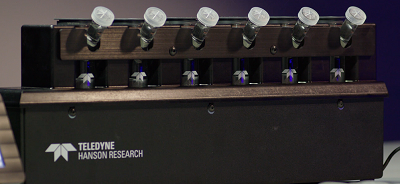
Cells filled with the media and equipped with a membrane can be placed in the Phoenix DB-6 block thermostat to provide constant temperature and proper mixing. It can accommodate up to 6 cells simultaneously. The magnetic mixing unit provides mixing between 200 and 900 rpm with an accuracy of ± 10%, and the temperature can be controlled between 30 and 40 oC (temperature accuracy: ± 1 oC). The operation requires a touch-screen control unit or RDS automated system.
Phoenix DB-6 manual diffusion system
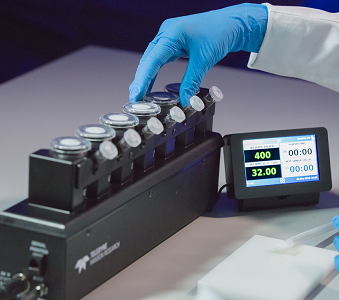 The system includes the DB-6 unit and the touch-screen control unit. The control unit can store 100 methods and 50 users. The mixing speed, temperature, test length and sampling times can be set. Audible signal alerts the user of the coming sampling time. The sampling can be done manually using a pipette or syringe. The test parameters can be printed with a paper roll printer.
The system includes the DB-6 unit and the touch-screen control unit. The control unit can store 100 methods and 50 users. The mixing speed, temperature, test length and sampling times can be set. Audible signal alerts the user of the coming sampling time. The sampling can be done manually using a pipette or syringe. The test parameters can be printed with a paper roll printer.
Phoenix RDS automatic diffusion system
The diffusion cells are also placed in the DB-6 unit, but the DB-6 unit is part of a robotic system (Robotic Diffusion Station, RDS) controlled by the Diffusion Master computer software. The system includes a one-position robotic arm, a syringe pump liquid handling unit, a wash unit, media prethermostat station, and a sample collector. The sampling and media replacement are performed by syringe pump. The sampling arm withdraws up to 0.5 ml sample, which is collected into HPLC vials with pre-slit septa. The cross-contamination among the cells can be avoided by using a peristaltic pump wash station. The receptor media is replaced from thermostatted vessels. The RDS can handle 2 DB-6 units, which means a total of 12 cells. In the software it is possible to specify the diffusion sampling parameters per cell, such as using different sampling times, volumes, wash parameters.
The software is 21 CFR Part 11 compliant and works in server-client system. The data and test reports are stored in an SQL database, can be exported or printed in pdf format. It has a detailed audit trail function for storing events, errors, and tests. A Diffusion Master software can handle two Phoenix RDS systems.
To find the most suitable diffusion system for the task, Teledyne Hanson has created an interactive website. There a manual or an automated system can be set up through a step-by-step process with figures and sizes of the components to help to choose between various cells, dosage and membrane holders.

